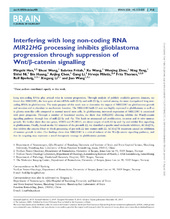| dc.contributor.author | Han, Mingzhi | en_US |
| dc.contributor.author | Wang, Shuai | en_US |
| dc.contributor.author | Fritah, Sabrina | en_US |
| dc.contributor.author | Wang, Xu | en_US |
| dc.contributor.author | Zhou, Wenjing | en_US |
| dc.contributor.author | Yang, Ning | en_US |
| dc.contributor.author | Ni, Shilei | en_US |
| dc.contributor.author | Huang, Bin | en_US |
| dc.contributor.author | Chen, Anjing | en_US |
| dc.contributor.author | Li, Gang | en_US |
| dc.contributor.author | Miletic, Hrvoje | en_US |
| dc.contributor.author | Thorsen, Frits | en_US |
| dc.contributor.author | Bjerkvig, Rolf | en_US |
| dc.contributor.author | Li, Xingang | en_US |
| dc.contributor.author | Wang, Jian | en_US |
| dc.date.accessioned | 2020-08-13T10:13:45Z | |
| dc.date.available | 2020-08-13T10:13:45Z | |
| dc.date.issued | 2020 | |
| dc.Published | Han M, Wang S, Fritah S, Wang X, Zhou W, Yang N, Ni S, Huang B, Chen A, Li G, Miletic H, Thorsen F, Bjerkvig R, Li X, Wang J. Interfering with long non-coding RNA MIR22HG processing inhibits glioblastoma progression through suppression of Wnt/β-catenin signalling. Brain. 2020; 143(2):512–530 | eng |
| dc.identifier.issn | 0006-8950 | |
| dc.identifier.issn | 1460-2156 | |
| dc.identifier.uri | https://hdl.handle.net/1956/23729 | |
| dc.description.abstract | Long non-coding RNAs play critical roles in tumour progression. Through analysis of publicly available genomic datasets, we found that MIR22HG, the host gene of microRNAs miR-22-3p and miR-22-5p, is ranked among the most dysregulated long non-coding RNAs in glioblastoma. The main purpose of this work was to determine the impact of MIR22HG on glioblastoma growth and invasion and to elucidate its mechanistic function. The MIR22HG/miR-22 axis was highly expressed in glioblastoma as well as in glioma stem-like cells compared to normal neural stem cells. In glioblastoma, increased expression of MIR22HG is associated with poor prognosis. Through a number of functional studies, we show that MIR22HG silencing inhibits the Wnt/β-catenin signalling pathway through loss of miR-22-3p and -5p. This leads to attenuated cell proliferation, invasion and in vivo tumour growth. We further show that two genes, SFRP2 and PCDH15, are direct targets of miR-22-3p and -5p and inhibit Wnt signalling in glioblastoma. Finally, based on the 3D structure of the pre-miR-22, we identified a specific small-molecule inhibitor, AC1L6JTK, that inhibits the enzyme Dicer to block processing of pre-miR-22 into mature miR-22. AC1L6JTK treatment caused an inhibition of tumour growth in vivo. Our findings show that MIR22HG is a critical inducer of the Wnt/β-catenin signalling pathway, and that its targeting may represent a novel therapeutic strategy in glioblastoma patients. | en_US |
| dc.language.iso | eng | eng |
| dc.publisher | Oxford University Press | eng |
| dc.rights | Attribution-Non Commercial CC BY-NC | eng |
| dc.rights.uri | http://creativecommons.org/licenses/by-nc/4.0/ | eng |
| dc.title | Interfering with long non-coding RNA MIR22HG processing inhibits glioblastoma progression through suppression of Wnt/β-catenin signalling | en_US |
| dc.type | Peer reviewed | |
| dc.type | Journal article | |
| dc.date.updated | 2020-01-28T13:55:20Z | |
| dc.description.version | publishedVersion | en_US |
| dc.rights.holder | Copyright 2019 The Authors | |
| dc.identifier.doi | https://doi.org/10.1093/brain/awz406 | |
| dc.identifier.cristin | 1784331 | |
| dc.source.journal | Brain | |
| dc.relation.project | Norges forskningsråd: ES563961 | |

